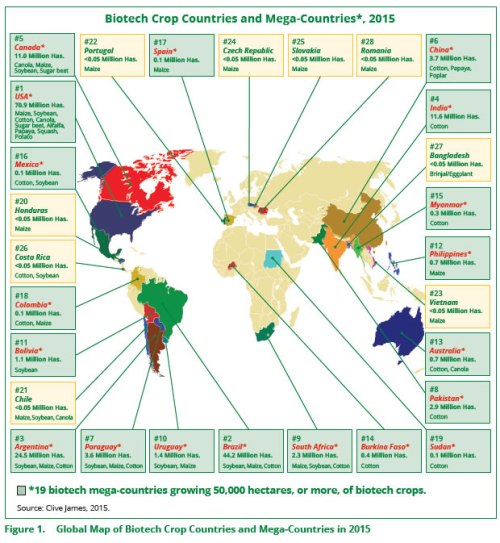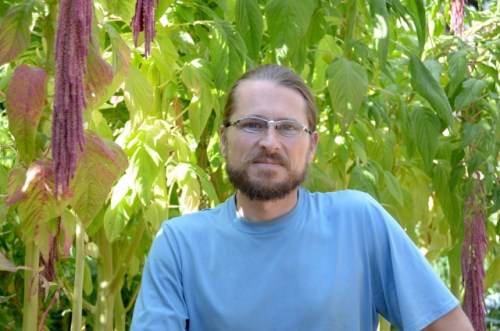Today is Day 12. I just passed the midway point of this 21 Days for World Hunger ordeal experience. I keep telling myself, “Just get through to next Wednesday, and then you’re home free.” Each day brings challenges, surprises, and more challenges. I wonder how I’ll feel come next Wednesday. Hopefully more hopeful.
If you’ve been following along, then you’ve probably noticed a theme here: Organic, small farmers will feed the world; toxic multinational chemical corporations will harm the planet.
Several years ago, I wrote a series called Get Your Gen Mo Out of My Food Yo about the issues revolving around genetically modified foods and solutions to protect ourselves from the hazards they cause. The articles have been published at a number of sites including GE-Free BC.
What is a GMO?
A Genetically Modified Organism (GMO) is an organism whose genetic makeup has been altered to serve another purpose. One may also see the terms GE (Genetically Engineered) and Transgenic. Take the gene of one species and put it into the gene of another. The idea of genetic modification has been around for a long time. For thousands and thousands of years, farmers have experimented to improve the quality of their crops through a process of selection and cross-breeding. Even with nature, plants and animals selectively breed. It’s nature’s way of assuring a strong gene pool. It’s that whole survival of the fittest thing. Today, the most prolific GMOs are crop plants developed in a laboratory not on a farm. Whereas traditional breeding is between reproduction of like organisms, today’s bioengineers isolate genes from unlike organisms (including bacteria, viruses and animals) creating an unnatural sequence and a synthetic outcome that requires artificial assistance to reach its full potential.
Genetically Modified (GM) Foods have had their DNA changed through genetic engineering. According to Jeffrey Smith, author of the #1 GMO bestseller Seeds of Deception, and Genetic Roulette, the four major GM crops are soy, corn, cotton and canola. Smith states there are two major traits of GM foods:
- about 80% are genetically engineered to not die when sprayed with herbicide
- about 20% are genetically engineered to create their own pesticide.A very small percentage of crops such as zucchini, crookneck squash and Hawaiian papaya are GE (genetically engineered) to resist disease.
What’s the Purpose of a GMO?
Well, according to Monsanto, a major player in the Gen Mo world, the purpose is to solve the world’s hunger problem as stated in a propagandized slogan disguised as altruism, building a world without hunger. That’s a curious statement coming from the chemical company that developed or produced toxic products like:
- Saccharin (a cancer-causing chemical)
- Agent Orange (an herbicide and defoliant that is responsible for 400,000 human deaths and disabilities in Vietnam as well as 500,000 birth defects)
- DDT (banned in 1972 because of toxicity – keeping in mind advertisements for DDT included the slogan ‘DDT is Good for Me’)
- rBGH (Bovine Growth Hormone also referred to as BST and with a trade name Posilac is a synthetic hormone given to cows to increase their milk production)
- PCB’s (banned in 1979 because of toxicity)
Monsanto, a company that’s been around since 1901 and one of the top 10 agrochemical companies, refers to themselves as an agricultural and seed company. Seed of what? The devil?
Does anyone else see the irony? A company whose sole intention is to make products that kill is in the business of making food? When did the world fall upside-down?
In the future, I’ll be reprinting some of my GMO articles on this blog, but in the meantime, you can read more here.
According to GM Watch, the world’s six largest agrochemical manufacturers, who control nearly 75% of the global pesticide market, are also seed industry giants. When I think of seeds, I think of life. When I think of pesticides, I think of death. Those two ideas do not belong together. Period.
These are the four agrochemical company leaders:
- Bayer: the world’s biggest agrochemical company is also the world’s seventh biggest seed company.
- Syngenta: the world’s second largest agrochemical company is also the world’s third largest seed company.
- Monsanto: the world’s biggest seed company is the world’s fifth largest agrochemical company.
- DuPont: the world’s second biggest seed company is also the world’s sixth largest agrochemical company.
And now, Bayer is buying out Monsanto inching closer and closer to a killer seed monopoly, or as this LA Times article states, “a global chemical and agricultural giant.”
Which Regions Ban GMOs?
To date, there are only eight counties in the US that have voted to become GE-free. Many others have tried but failed in the face of BigAg money that pumped millions and millions of dollars into fighting against the voters’ choices. This, along with counties and states that want the right to label*, have all failed because the Agrochemical companies have a LOT of money, and they intend to keep it, compound it, and add to it through increased sales of their toxic products.
*Three states (Vermont, Connecticut, and Maine) have passed GMO labeling laws, but President Obama signed into law the Dark Act, which will put the kibosh on any labeling laws currently in effect and any future state laws. It’s a heartbreak for all who fight so hard against the machine of BigAg with their BigBucks. Total sleight of hand stuff with dollars being magically pulled out of ears and placed into pockets. Groups are rising up to fight it, and I have no doubt it will end up in federal court. Read more here at the HuffPost.
I borrowed this map from the Genetic Literacy Project. Check out which countries have bans and which offer a free-for-all for BigAg to control food sovereignty.
 The following map showing the global area of biotech crops can be found at ISAAA (International Service for the Acquisition of Agri-Biotech Applications) where they’re celebrating the 20th anniversary of genetically modified crops. They, alone, celebrate as biodiversity crumbles beneath the weight of their overflowing coffers. They attempt to hold on, tight-fisted, to their grip on global food sovereignty, but hope in the form of organic farming is growing.
The following map showing the global area of biotech crops can be found at ISAAA (International Service for the Acquisition of Agri-Biotech Applications) where they’re celebrating the 20th anniversary of genetically modified crops. They, alone, celebrate as biodiversity crumbles beneath the weight of their overflowing coffers. They attempt to hold on, tight-fisted, to their grip on global food sovereignty, but hope in the form of organic farming is growing.

Why Organic?
Meet Chris Hardy, a Southern Oregon organic farmer. Chris evolved in the field of organic farming through an inspiration to support a shift in how the world feeds itself. He’s traveled extensively observing farming practices in different parts of the world. His passion as an organic farmer and a consultant and educator includes the use of regenerative forms of agriculture and building community seed relationships as the foundation for sustaining future generations. Chris initiated the historic campaign in Southern Oregon to ban genetically engineered crops (GMOs) and brought farmers and citizens together to protect a way of life for those who use organic traditional seed saving practices. Thanks to Chris along with the tireless efforts of local farmers and citizens alike, Jackson County, Oregon is GE-free.

Beyond organic agriculture and seed culture development, Chris’ specialities include farm management, marketing, regenerative agriculture consulting, heavy equipment operator, farm education for youth, ecological education, food preservation, nutrition and international relations.
Grab a cuppa joe and spend a few minutes with Chris who answers the questions: Why Organic? and Can Organic Feed the World?

One Little Asian Country Making Big Organic Strides: Bhutan
As I embark upon my world hunger research for Asia, I’m happy to share a success story from Bhutan. According to a 2013 UN article, Bhutan has agreed upon the UN Sustainable Development Goals (SDGs) which includes, “End hunger, achieve food security and improved nutrition and promote sustainable agriculture.” That same year, Bhutan solidified their commitment to sustainable agriculture after sharing its plan to become the first country to use only organic farming methods. Bhutan aims to become a world leader in organic farming by 2020. Think Progress has a fabulous article on Bhutan and their beautiful, ambitious, sustainable goal. Bhutan is considered one of the happiest countries in the world. I wonder if there is a correlation? Organic = happy.
There’s more good news! Malta is banning Roundup/glyphosate, the world’s #1 herbicide that the World Health Organization has deemed a probable carcinogen. France may follow soon, and two-thirds of Europeans support a ban on Roundup.
Day 12: My Food Justice Diet Experience
While I’ll continue with the Food Justice Diet tomorrow, I need to take the day off from blogging, because work and another writing gig demand my attention. My attention demands my attention. I’ve been foggy all day forgetting what I intend to write forgetting what I intend to write.
I’ll be back on Day 14. Get ready for the final week of 21 Days for World Hunger. We can do this thing. Right?
Day 12 Nutrition Information
Weight: 113
Fat = 36.4%
Carbs = 53.8%
Protein = 9.8%
My awesome blossom husband made us stir-fry tonight – potatoes, red peppers, broccoli, and basmati rice. Yum. Yum. Plus there is enough for leftovers tomorrow. Leftovers = no cooking + not spending time figuring out nutritional information = an opportunity to get an hour of R&R.
~~~~~~~~~~~~~~~~~~~~~~~~~~~~~~~~~~~~~~~~~~~~~~~
“If the Americans like to eat GMO products, let them eat it then. We don’t need to do that; we have enough space and opportunities to produce organic food.”
~Dmitry Medvedev, prime minister of Russia
“When we say happiness, it’s not just happiness of humans. It’s happiness of the soil, happiness of the animals, happiness of all sentient beings.”
~Appachanda Thimmaiah, Bhutan’s agricultural adviser from 2008 to 2013 and associate professor of sustainable living at Maharishi University of Management in Iowa
~~~~~~~~~~~~~~~~~~~~~~~~~~~~~~~~~~~~~~~~~~~~~~~
To read other posts in this series, click click click the links. Please share your comments!
Day 1: The Food Justice Diet
Day 2: Alarming and Curious Statistics
Day 3: Finish Your Plate, There are Children Starving in Ethiopia
Day 4: The Nameless Hungry
Days 5-6: “Where Does She Get Her Protein??”
Day 7: One Small NGO Making a Big Impact in Ethiopia
Day 8: The Language of Hunger
Day 9: Plenty of Soy Solutions in Latin America
Days 10-11: Can Small-scale farming feed the world?
Day 12: Why Organic Farming?
Days 13-14: The Have and Have-Nots of Southeast Asia
Day 15: Have You Eaten Today?
Day 16: Hunger in America
Days 17 & 18: Hunger’s Dirty Little Secret
Day 19: Eat Plants
Day 20: Watch This, Read That
Day 21: The Power of Activism





Great videos Kenda!
Thanks Annie B!
Great article! Organically grown veggies not only taste SO MUCH better, they are better for you and for the soil they’re grown in. And this whole movement / pseudoscience belief, this technology-worshipping horse poop that claims organic farming can’t feed the world, they are not paying attention to WHY people are dying of hunger. Just like anything else on our planet, it’s more about the money than anything else. Hunger is a DISTRIBUTION PROBLEM, not a growing problem. If there’s no $$$ to be made in feeding the poorest, then the poorest aren’t going to get fed, unless non-market solutions are employed.
Thank you my wonderful, organic, Mr. Pepper!